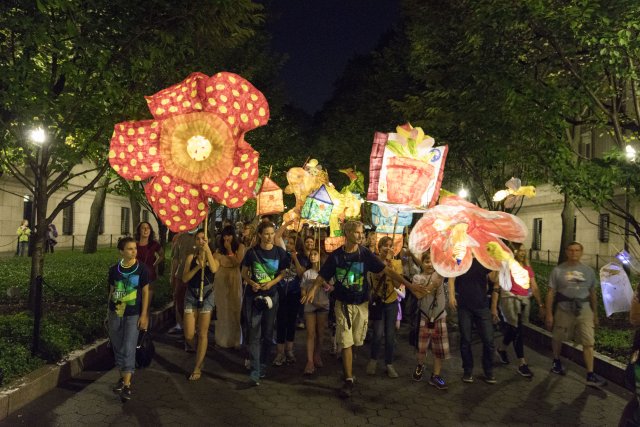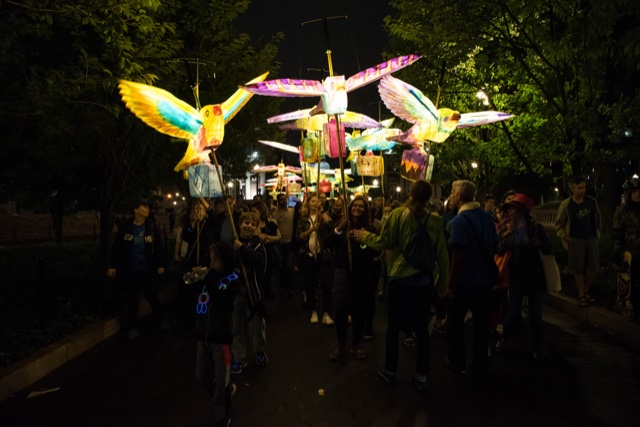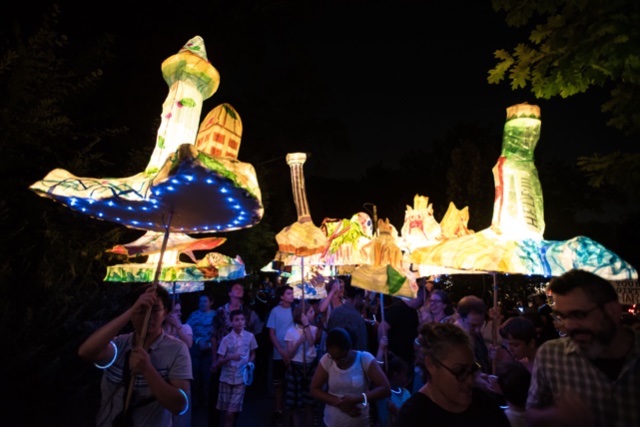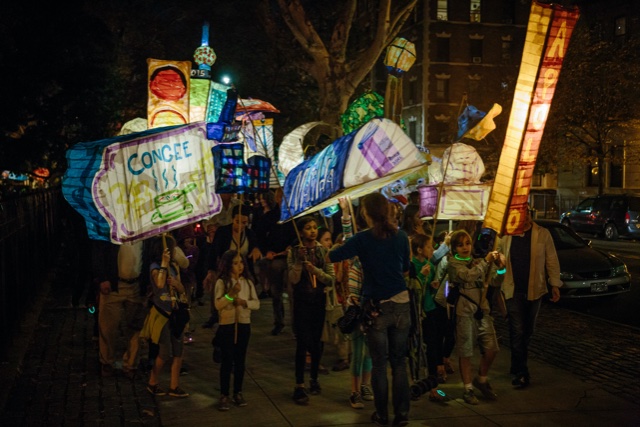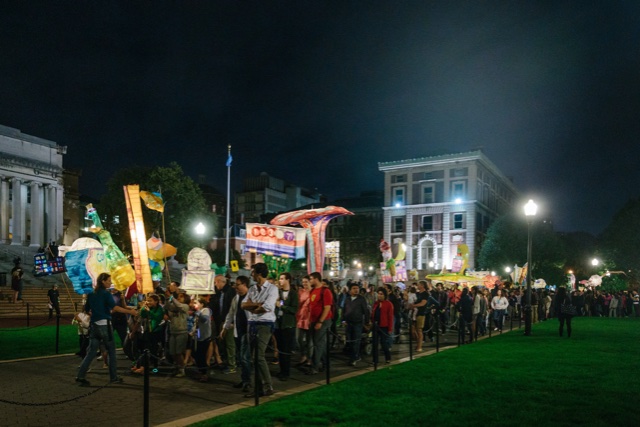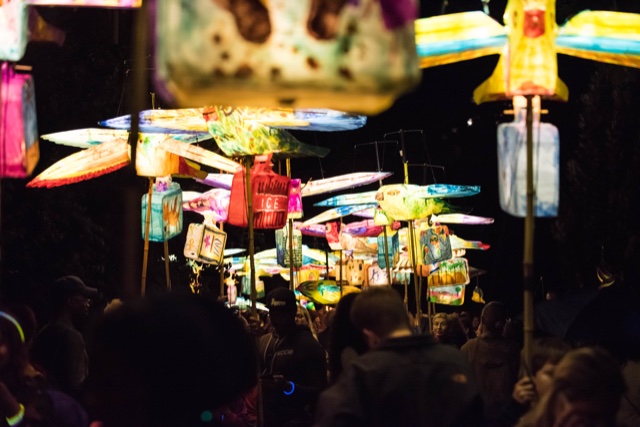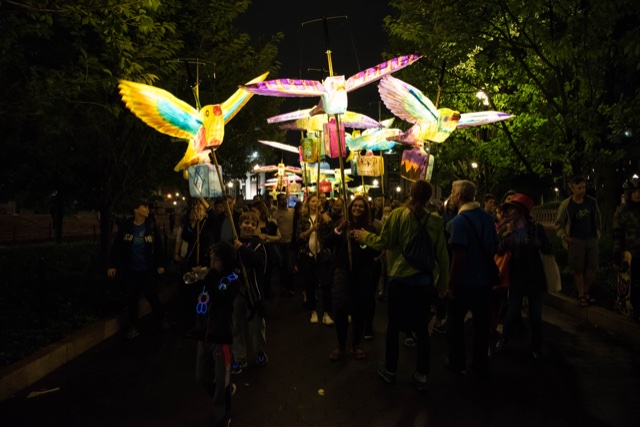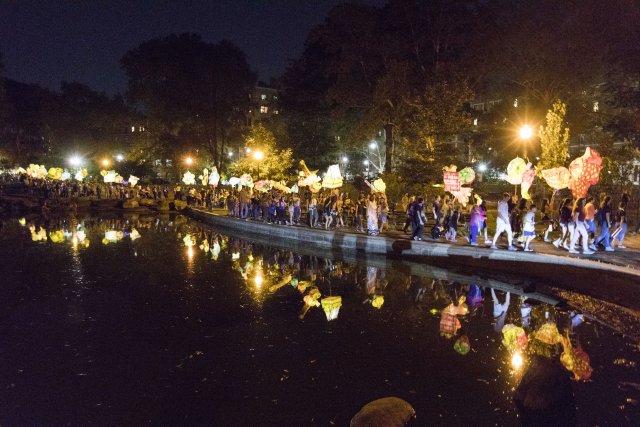Processional Arts Workshop at Columbia U.
Alex Kahn and Sophia Michahelles, Artistic Directors
By: Susan Hall - Sep 20, 2022
The beloved neighborhood tradition of shaping our stories in light returns, in person for the first time since 2019. Starting on September 17, Miller Theatre opens its doors for a week of free lantern-building workshops, culminating in a magical illuminated procession through Morningside Park.
The theme of the 11th Morningside Lights is centered around how we memorialize. The Reimagined Monument is a timely invitation to the community of makers to rethink the convention of public statuary, creating their own monuments to speak to the current moment, shared past, and hopes for the future.
Alex Kahn and Sophia Michahelles, Artistic Directors of the Processional Arts Workshop speak about their work.
BFA: Have you ever been presented with a challenge you could not meet? If so, how did you handle this?
Every project we do is site-specific, and unique to the community with whom we are collaborating. We always enter into the process with certain images, assumptions and open questions, but as we listen to what a given space, place, and situation has to say, we always refine and essentialize to get to something meaningful that can be made within the practical parameters of the project. So, in a sense, every project diverges from our initial expectations and becomes clearer and better because of what we cut or alter.
BFA: What is your favorite puppet ever created? If it is not yours, what is your favorite puppet you created?
Puppets are often a part of what we do, but they’re not essential to our mission. Our main focus is on exploring the medium of community-built procession as a form of contemporary ritual theatre. Giant puppets can be a powerful tool for storytelling in procession, but we also employ masking, costume, mobile architecture and – notably in the case of Morningside Lights – lanterns and other illuminated structures. Perhaps all of these things, as materials in motion, could broadly be considered puppetry of a sort, under the rubric of what John Bell calls “performing objects”
BFA: How did you come to do puppets for the Halloween Parade in Greenwich Village?
Puppets have led the NY Village Halloween Parade since Ralph Lee started it in 1974. I (Alex Kahn) apprenticed with performance designers who inherited and built on Ralph’s tradition of pageant puppetry, and then in 1998, Sophia and I came together to design 25th Anniversary Parade in 1998. She came from a background in architectural history and theatre. I had a fine arts background in painting and installation and had designed sets lighting and a puppets in NY.
BFA: What is the difference between working with willing amateurs and professionals in your studio? What is the difference between working with a community that understands and has created these events and newcomers?
Many of our volunteers bring expertise and experience far beyond our own. We learned that when we first started leading open community workshops to create our work in 1998. That year, we had aimed to create five 20’-tall metamorphosing Luna Moths for the Halloween Parade, and knew with our minimal staff we would never meet our production deadline. So we sent drawings out to the whole community and invited people of all skill levels to come in and help realize our vision. More than 30 people turned up – including accomplished costumers, painters, welders, and chefs. Powered by soup, bread, and music, and working alongside less-experienced makers, they accomplished more in a day than we had done in a month. From that day onward, this practice of collective building, which we called Puppetraisings, became central to our process and our mission. From a practical standpoint it is the only way work on this scale can happen in everyday places with limited funding. But more significantly, the act of building something artful together – how that galvanizes a community – is just as important as the final outcome.
But the volunteers bring much more than just their hands to a project. Often we simply frame a general theme or architecture, and our participants fill in the specifics with their own imagery, personal histories, and cultural perspectives. They become the real authors of the work and we act as agents or editors of their vision. For Morningside Lights, the intergenerational conversations that take place over the worktables – on themes from Pulitzer-Prize winning poets, to Utopian architecture, to bioluminescent life forms, or artists of the Harlem Renaissance – these exemplify what this work is all about.
BFA: What is the largest installation you have ever done?
When we designed the opening for the Walkway Over the Hudson, we created a dual processions for over 3000 participants, that crossed the space from opposite sides of the Hudson. What was amazing about this performance was that there was no audience – there was no room for anyone but us up there, so it really took on the feeling of a secular ritual more than a spectacle. We created similar participant-only performance for the opening of the Rail Yards section of the High Line in 2014.
BFA: Do you have a preference, large or small?
Whatever the site and situation call for. Small multiples can animate a vast space in procession, and singular giant puppets can get very small, when they engage a passer-by with a moment of face-to face or hand-to-hand intimacy.
BFA: Can you explain the process of lighting?
The giant lanterns for an event like Morningside Lights were inspired by the giant lanterns that parade for Fasnacht, the Carnival in Basel, Switzerland. Those lanterns were traditionally illuminated by flaming propane oven-jets, but with LED technology having come so far, we prefer using 12-volt LED bulbs powered by small rechargeable batteries. Ultimately we want to charge our batteries through solar cells, so that light from the day is borrowed to illuminate the night.
BFA: Carnival Dragon band and class divisions and conflicts in the Caribbean? Storming the stage without permits, for instance.
We spent 6 months in Trinidad on a Fulbright studying their Carnival traditions, but also working in several of the most economically disadvantaged neighborhoods in Port-of-Spain. The economic inequality was inescapable and stark, and its reflection in the economics of modern Carnival provided the impetus for us to re-work the traditional Dragon Band as an act of dissent. But as outsiders, we also knew it was not our story to tell, nor was it our role to judge or politicize. So instead we listened; we asked a lot of questions; we proposed drawings to see how the Trinidadians we met responded. In the end, we became more the catalysts or distillers of a collective vision than authors of our own creation. The Trinidadians who joined our performance felt, they were doing something truly subversive in response to increasingly commercialized Carnival culture (especially when we crossed the stage anonymously without a Carnival registrations)
BFA:To what extent are you always what you refer to as “time out of time”?
Anthropologist Alessandro Falassi uses that expression to convey how our experience of time is altered and dilated in a festive rituals, similarly to how we dream. To us, it implies that a space activated by processional performance is transformed, not just for the duration of the performance but permanently in memory, as if the memory of the moment soaked into the pavement and the space can never be seen quite the same way again. When processions become annual events, this only reinforces the altered image of a public space, adding layer after layer to memory left in the wake of each repeated performance. For those who have witnessed Mornigside Lights, either as participants or passers-by, the experience of the Park is inextricable from the lingering afterglow of giant lanterns on the move.

